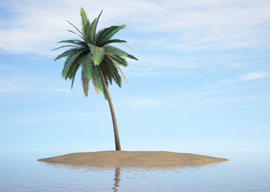
October 29, 2012

Islands can even be pocket hells where kings become convicts, such as Napoleon on St. Helena”places of eternal exile from decency as well as society, where evil is amplified because there is no alternative or escape. As the author says,
Human beings traveling far and wide have turned into the very monsters they chased off the maps.
We bring freight when we arrive at any island”rats in our luggage that race into the pristine paradise to lay waste the new land and replicate the troubles we have fled. Like the schoolboys in Lord of the Flies, we are imprisoned by inner-animal limitations as well as by logistics”and the open-eyed author duly brings us artfully imagined real-life horrors.
There is the dystopia of Tikopia, 700 miles to the east of Fiji, so small that even in the center of the island one can hear the waves” maddening boom, home to 1,200 people who until recently practiced a ruthless euthanasia policy for all whom the island’s knife-edge ecology could not sustain. Only elder sons were permitted to reproduce, with superfluous newborns placed on their faces to suffocate.
There is the saga of Pitcairn Island, where Fletcher Christian’s fugitives landed on the run from Royal Naval retribution and literally burned their boats to become rulers for a time, only to fight murderously and eventually inbreed themselves into casual acceptance of systemic sexual abuse.
There are cast-up corpses on the Marshall Islands, murder mysteries from the Galapagos, rumors of Antarctic anthropophagy, and the melodramatic tale of Clipperton Atoll, a Mexican colony forgotten when Mexico dissolved into revolution and the rest of the world into World War I. The US Navy offered the residents evacuation in 1915, but the proud governor paraded his mound of ancient guano in Austrian-inspired parade uniform, arm-in-arm with his bejeweled wife, to reassure the governed that they could weather the world storm together, even on an island without grass and infested by millions of ravenous crabs.
But the ships from Acapulco stopped coming, their food ran down, and scurvy came calling to whisk one after the other away. The governor was drowned when he set out in a boat to get to a (possibly imaginary) passing ship, and soon the only man left was the lighthouse keeper/king, who raped and killed for two years before one of his victims beat him to death with a hammer. A providential US warship then took off the few women and children survivors, who recorded looking back at their receding prison and for a long time being able to see the orange of the crabs.
The author ranges across all atlases, strewing insular images across our mental maps. We see whaling charnel houses where jawbones jut from still-sticky sand…grass-covered shipwrecks surrounded by defensive penguins…the genetic color-blindness of the people of Pingelap…the bird-faced goddess of Banaba…the last radio message of Amelia Earhart…atom bombs on atolls…the sad tale of the trusting Steller’s sea cow, hunted to extinction…US Marines iconically raising the Stars and Stripes atop Iwo Jima’s Mount Suribachi…and dozens of other highly theatrical productions lent force and poignancy by the smallness of their stage.
Finally, she gives us some of the world’s last few untouched islands, still too difficult or dangerous to reach, or simply thought not worth visiting. Judging from the harm caused by human visitors and their forces of progress, such places are probably safer being ignored. Perhaps we have a psychic need to know that there are some islands still inviolate and that sometimes it is better to travel hopefully than to arrive.
Image of desert island courtesy of Shutterstock